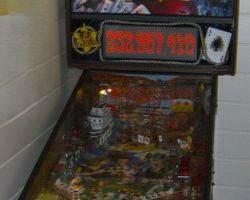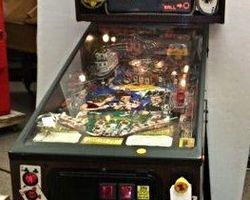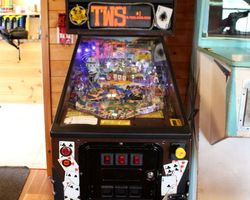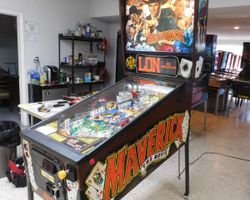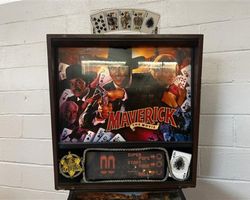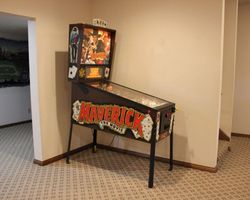Maverick
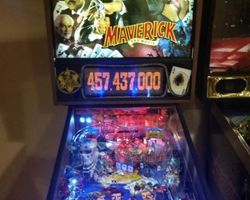
Average Prices: USD $700 to $2,000
Produced: September, 1994
Machine Type: Solid State Electronic
MPU: DataEast/Sega Version 3b
Players: 4
Concept by: Tim Seckel, Joe Kaminkow, Neil Falconer, Orin Day, Lyman F. Sheats Jr., Lonnie D. Ropp
Design by: Tim Seckel
Art by: Morgan Weistling
Dots/Animation by: Kurt Andersen, Jack Liddon, Scott Melchionda, Mark Raneses
Mechanics by: Tim Seckel, Norm Wurz
Music by: Brian Schmidt
Sound by: Brian Schmidt
Software by: Lyman F. Sheats Jr., Lonnie D. Ropp
The pinball machine "Maverick," released by Data East USA, Inc. in September 1994, is a captivating entry in the manufacturer’s extensive catalog. Drawing its theme from the popular western film of the same name, which itself was based on a classic television series, "Maverick" seamlessly blends the high-stakes world of poker and the adventurous spirit of the Wild West into a cohesive pinball experience. This machine holds a distinct place in pinball history as the final title produced by Data East and the first to be released under the Sega Pinball, Inc. banner, a transition marked by the subtle presence of both companies' branding – the Data East logo on the shooter rod and the Sega logo on the display.
The development of "Maverick" was a collaborative effort, bringing together several skilled individuals. Tim Seckel led the design, crafting a playfield that would accommodate the game's unique thematic elements. The visual appeal of the machine was shaped by the artistic talents of Markus Rothkranz and Morgan Weistling; notably, "Maverick" marked Weistling's first foray into pinball artwork. The auditory landscape was composed by Brian Schmidt, responsible for both the music and sound effects, which included custom speech provided by Fred Young for various characterizations. Software integration was handled by Lonnie D. Ropp and Lyman F. Sheats Jr., while animation for the groundbreaking display was created by Jack Liddon, Kurt Andersen, Mark Raneses, and Scott Melchionda. Norm Wurz also contributed to the machine’s mechanical engineering alongside Tim Seckel. An intriguing piece of trivia surrounds the artwork on the playfield: initial prototypes depicted actor James Garner at the poker table, but Warner Brothers, the film’s distributor, mandated a change for production, ensuring Garner was depicted seated at the poker table in a different pose, thus aligning the machine more closely with the film's visual identity. Early in its development, "Maverick" was tested as a widebody pinball machine featuring a standard 128x32 dot matrix display (DMD), but the production model transitioned to a standard body with an innovative, larger 192x64 pixel DMD, driven by a 16-bit (68000 driven) dot matrix controller – a significant technological leap for its time. The widebody prototype was subsequently destroyed, with only a single prototype playfield known to still exist.
Signature Features and Design
"Maverick" distinguishes itself with several unique features that directly integrate its poker and western theme into the gameplay. Central to the playfield is the "Lauren Belle" steamboat, a prominent mechanical toy that serves as a ball lock mechanism. Players aim to shoot balls into the steamboat, where they are held, creating anticipation for a multi-ball sequence. This riverboat, with its paddlewheel, provides a visual centerpiece and a strategic target.
Adding depth to the game’s core poker theme are an impressive seventeen drop targets, spread across four distinct banks: two five-bank targets, one four-bank target, and one three-bank target. These targets are designed to represent poker cards, with players collecting them to form various poker hands. The sheer number and strategic placement of these drop targets ensure that accurate shooting is paramount to progress.
A major technical highlight for "Maverick" at the time of its release was its extra-large 192x64 pixel Dot Matrix Display (DMD). This expanded display allowed for more detailed animations and visual storytelling, enhancing the immersive qualities of the machine’s movie license. The custom animations and graphics displayed on this larger screen contributed significantly to the game's captivating presentation. Further enhancing the thematic immersion, the plunger handle itself is shaped like a stack of poker chips, bearing a subtle Data East stamp, a small yet engaging detail. In the backbox, an illuminated "Royal Flush Card" topper adds an extra layer of visual flair, signaling successful gameplay and reinforcing the high-stakes gambling theme.
Playfield and Mechanics
The "Maverick" playfield is designed with a keen eye for both thematic integration and engaging shot variety. It features a standard three-flipper layout, providing players with distinct shot opportunities from different areas of the playfield. Three pop bumpers located strategically on the upper playfield keep the ball active and unpredictable, contributing to scoring and flow. Two slingshots at the bottom of the playfield offer classic pinball rebound action.
The seventeen drop targets are fundamental to the playfield’s design philosophy. These targets are not merely obstacles but active components of the game’s core rules, acting as "cards" that players collect to build poker hands. Surrounding these banks are various standup targets and a single ramp that guides the ball through different sections of the playfield, contributing to the overall flow. A Vertical Up Kicker (VUK) provides opportunities for ball re-entry or specific mode activation. Below the Lauren Belle riverboat, a captive ball offers a satisfying and rewarding shot, often leading to bonus points or progressing game modes. The general flow of the playfield encourages players to aim for specific targets to advance their poker hands and activate modes, although the Lauren Belle itself can sometimes interrupt the pace due due to its ball lock and release times. The artwork on the playfield, while generally well-regarded for its integration of the western and poker elements, captures the essence of the film’s setting. Lighting throughout the playfield emphasizes targets and ramps, guiding the player’s attention and enhancing the overall aesthetic.
Gameplay Dynamics
The gameplay of "Maverick" centers heavily on its integrated poker theme, offering a unique blend of traditional pinball action and strategic card playing. The primary objective revolves around collecting the drop targets to form poker hands, mirroring the experience of playing cards. Players can "raise" or "fold" their hands, introducing a layer of risk-reward strategy to the game. Successfully completing hands advances the player through a series of poker-themed objectives and contributes significantly to their score. This mechanism rewards not only accurate shooting but also tactical decision-making, as players weigh the value of their current "hand" against the potential for higher-scoring combinations.
Multiball, a staple of modern pinball, is initiated through interaction with the Lauren Belle steamboat. Locking multiple balls in the riverboat triggers a four-ball multiball, creating a chaotic and high-scoring opportunity as players juggle multiple balls on the playfield. The game also features a unique "Video Blackjack" mode on its large DMD, which further reinforces the gambling theme and offers a mini-game diversion from the main pinball action. A challenging skill shot at the game’s start rewards precision plunging, adding an immediate test of player control. The rules are designed to be accessible for casual players to understand the basic objectives of hitting targets and building hands, yet they offer sufficient depth and strategic nuances to keep experienced players engaged in mastering the optimal shots and poker strategies for high scores. The integration of custom speech and movie quotes further immerses players in the "Maverick" universe, providing auditory cues and thematic flavor during gameplay.
Reception and Legacy
Upon its release and in the years since, the "Maverick" pinball machine has garnered a largely positive reception within the pinball community, frequently described as an underrated gem. Its most lauded strength lies in the cohesive integration of its poker theme. Players often praise how seamlessly the mechanics, particularly the drop targets functioning as "cards," merge with the gameplay, allowing them to truly "play poker" on a pinball machine. The strategic depth introduced by the ability to raise or fold poker hands, combined with challenging shot layouts, provides an engaging experience for those who appreciate more than just raw speed in their pinball. The blend of western aesthetics with gambling mechanics, alongside well-integrated music, sound effects, and movie quotes, contributes to a distinct and enjoyable atmosphere. Many find the rules straightforward to grasp, yet demanding to master, offering sustained appeal for both new players and seasoned enthusiasts. Furthermore, its market value often makes it an attractive acquisition for collectors seeking a feature-rich machine without a premium price tag, making it a compelling "starter" pin that many choose to retain.
However, "Maverick" is not without its points of contention. The "Lauren Belle" riverboat, while visually striking and central to the multiball feature, is frequently cited as a weakness. Many players feel that the ball lock and release sequences within the riverboat disrupt the overall flow of the game, introducing pauses that can detract from the fast-paced nature of pinball. The shot to the upper flipper, often required for specific objectives, is also sometimes criticized for being overly difficult to hit consistently. Aesthetically, while the playfield art generally receives approval, the cabinet’s predominantly brown color scheme and the specific backglass image featuring a grinning Mel Gibson have drawn criticism from some who find them unappealing or not up to the artistic standards of some contemporary Data East titles. Despite these criticisms, the overall sentiment remains strong, with the thematic depth and unique gameplay mechanics generally outweighing the perceived flaws.
"Maverick" holds a notable legacy as the last pinball machine produced by Data East and the first under the Sega Pinball brand, marking a significant transitional moment in the history of American pinball manufacturing. Beyond its historical significance, its pioneering use of the larger 192x64 DMD set a precedent for more complex and visually rich animations in subsequent pinball machines. Its unique approach to integrating a licensed theme through a core gameplay mechanic—the poker hand building via drop targets—stands as an example of innovative design. "Maverick" continues to be viewed as a machine that offers considerable enjoyment and strategic depth, ensuring its place as a recommended experience for pinball enthusiasts.
Sponsored Links
 Ebay Listings
Ebay Listings
 Auction Results
Auction Results
| Cost | Location | Date |
|---|---|---|
| USD $3,050 |  California, United States California, United States |
03 September, 2025 |
| EUR €1,450 |  Nordrhein-Westfalen, Germany Nordrhein-Westfalen, Germany |
22 June, 2025 |
| USD $1,581 |  New Mexico, United States New Mexico, United States |
26 March, 2025 |
| USD $3,600 |  United States United States |
27 December, 2024 |
| USD $1,725 |  Pennsylvania, United States Pennsylvania, United States |
08 September, 2024 |
| GBP £4,250 |  United Kingdom United Kingdom |
13 July, 2024 |
| USD $1,225 |  Pennsylvania, United States Pennsylvania, United States |
17 June, 2024 |
| USD $1,900 |  Maryland, United States Maryland, United States |
06 June, 2024 |
| USD $1,825 |  Pennsylvania, United States Pennsylvania, United States |
23 March, 2024 |
| USD $5,000 |  Florida, United States Florida, United States |
14 March, 2024 |


Private Policy · Search Website · Contact Us
As an eBay Partner, we may earn a commission from qualifying purchases made through links on this site, at no additional cost to you.
All trademarks and copyrighted materials remain property of their respective owners. All other content copyright 2007 - 2025 Pinpedia.

